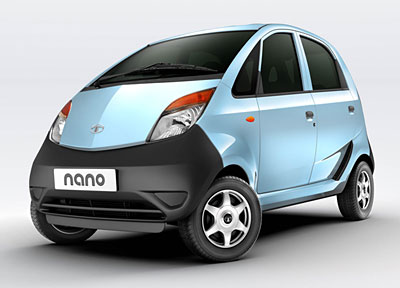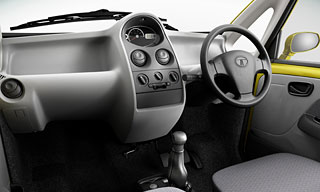Mini (or mini) nomenclature isn't the only iconic brand name Apple
shares with the automotive world. There's a new four-wheeled Nano that
could turn out to be as much of a game-changer as Alex Issigonis's
original
Austin/Morris Mini car was exactly 50 years earlier in 1959 - the
revolutionary Tata Nano
launched on March 9 by Tata Motors in Mumbai, India is the cheapest car
in the world - the "netbook" of automobiles, if you will.

Tata Motor's revolutionary, affordable Nano.
Revolutionary Minimalism
Tata's Nano follows the wheel-tracks of previous car for everyman
revolutions like the aforementioned Mini, the French Citroën 2CV,
the Italian Fiat
500, and Ferdinand Porsche's original Volkswagen Beetle. Tata's
nano will sell for about 100,000 rupees (roughly US$2,050) as a
people's car bringing automobile ownership within reach of millions of
low-income families now making do with often bizarrely overloaded and
unsafe two-wheeled - or just two-legged - transport.
Speaking at the Nano's unveiling ceremony last year, Mr. Tata
said,
"I observed families riding on two-wheelers - the
father driving the scooter, his young kid standing in front of him, his
wife seated behind him holding a little baby. It led me to wonder
whether one could conceive of a safe, affordable, all-weather form of
transport for such a family. Tata Motors' engineers and designers gave
their all for about four years to realize this goal. Today, we indeed
have a People's Car, which is affordable and yet built to meet safety
requirements and emission norms, to be fuel efficient and low on
emissions. We are happy to present the People's Car to India and we
hope it brings the joy, pride and utility of owning a car to many
families who need personal mobility."
Tata Motors
Never heard of Tata Motors? It's India's largest automobile company,
with revenues of $7.2 billion in 2006-2007, and the company is famous
throughout the developing world for its heavy duty trucks. Tata also
builds conventional sedans, SUVs, and pickups.
The
company's profile was raised in the West when it bought Britain's
Jaguar Motors
and Land Rover subsidiaries from beleaguered
Ford Motor Company last year.
The Italian-styled Nano shares superficial resemblance to Daimler
AG's SmartFor2 minicar, but it's
more practically utilitarian, with four doors and a roomy passenger
compartment that can seat four six-footers or even five friendly
adults.
The Nano's superlight 1,300 pound weight and rear-mounted aluminum,
two-cylinder, 623 cc, 33 horsepower, multipoint fuel injected engine
with electronic management and a balance shaft for smooth running gives
the Nano one of the lowest carbon footprints among automobiles - and
fuel efficiency of 50-plus miles per gallon. The Nano's tailpipe
emission performance also exceeds tough European regulatory
requirements, making it a lot less of a polluter than the oil-burning
two-cycle two-wheelers it's expected to displace in the market, so
hand-wringing by environmentalists over the introduction of affordable
transportation for the masses seems a bit misplaced, unless one buys
into the notion that only rich elites and Westerners should enjoy the
comfort and convenience of private automobiles.
 'A
Real Car'
'A
Real Car'
Reception by the automotive press has been generally positive, with
Automobile Magazine's Ben Oliver, who has ridden in a Nano,
giving it thumbs-up for interior room, standard of finish, respectable
acceleration, and handling performance, making the cut as a "real car,"
and suggesting the Nano could become the Ford Model T of the 21st
Century.
Apple's iPod nano
Thus far, Apple has only applied nano branding to its mid-range
series of iPods and no computer models, although some of us hold out
hope for a netbook-type MacBook nano laptop.
iPod nano 1G - Aluminum and Bright Colors
 The iPod nano was
rolled out September 7, 2005, the second iPod based on solid state
flash memory rather than electromechanical hard drives for storage (the
iPod shuffle
was the first, released on January 11, 2005). The original iPod nano
had a 2-inch QVGA (320 x 240) display, a downsized clickwheel
(introduced with the earlier iPod mini), and was
available in black and white with capacities of 2 GB or 4 GB
for $199 and $249 respectively. On February 7, 2006, a 1 GB model
was added at $149.
The iPod nano was
rolled out September 7, 2005, the second iPod based on solid state
flash memory rather than electromechanical hard drives for storage (the
iPod shuffle
was the first, released on January 11, 2005). The original iPod nano
had a 2-inch QVGA (320 x 240) display, a downsized clickwheel
(introduced with the earlier iPod mini), and was
available in black and white with capacities of 2 GB or 4 GB
for $199 and $249 respectively. On February 7, 2006, a 1 GB model
was added at $149.
The first generation iPod nano got off to a bit of a rocky start,
some early adopters reporting premature display surface scratching
and/or screen cracks. Apple eventually confirmed a very small
percentage of early nanos had shipped with faulty displays and agreed
to replace any nanos with cracked screens.
iPod nano 2G
- Aluminum and Bright Colors
A second
generation (2G) iPod nano was launched on September 12, 2006,
featuring a scratch-resistant anodized aluminum enclosure similar to
the earlier iPod mini's design and available in several color choices -
silver, green, pink, blue, and black. A (Product) Red version was added
later.
The 2G nano also got "a brighter, more vibrant display", a battery
life upgrade (from claimed 14 hours to 24), and doubled storage at 2,
4, and 8 GB with gapless playback support.
iPod nano 3G - Form-Factor Divergence
 The third-generation iPod
nano was rolled out on September 5, 2007 to decidedly mixed
reviews, due to its abandonment of classic iPod nano proportions for a
shorter, wider, heavier form factor accommodating its horizontal 2"
QVGA screen displaying the same resolution as the larger iPod Classic's
2.5" display at a smaller dot pitch.
The third-generation iPod
nano was rolled out on September 5, 2007 to decidedly mixed
reviews, due to its abandonment of classic iPod nano proportions for a
shorter, wider, heavier form factor accommodating its horizontal 2"
QVGA screen displaying the same resolution as the larger iPod Classic's
2.5" display at a smaller dot pitch.
Functionally, the 3G nano got Cover Flow support, a new user
interface, and video playback. It was available in silver, turquoise,
mint green, black, and (Product) Red. A pink 8 GB
model came along the following January.
iPod nano 4G - A Return to Tradition
Keeping with Apple's
clockwork annual nano revisions, the fourth generation iPod
nano debuted on September 9, 2008, reverting to the slimmer,
"traditional" iPod nano form factor of the 1st and 2nd Generation
nanos, but retaining the 3G model's screen size and resolution - only
oriented in "portrait" rather then "landscape" mode. The 4G nano is
able to shift between portrait and landscape display modes by tilting
the iPod to the left or right.
The 4G nano comes in silver, purple, blue, green, orange, yellow,
pink, (Product) Red, and
black "nano-chromatic" colors. New features include an accelerometer,
which goes into shuffle mode when you shake the iPod, and iTunes 8
Genius technology, which automatically creates thematic playlists from
your music library with just one click. The 4G model is the first nano
that does not support FireWire charging. (All nanos use USB for data
and charging.)
Products for the Masses
Like the iPod nano, the Tata Nano is targeted as a product for the
masses, selling for a low price but offering a decent inventory of
features and capabilities, albeit with some compromise necessary, but
with luxury features like air conditioning and electric window lifts
available.
Will
we ever see the Tata Nano in North America?
That seems to be part of Tata's mid-term game plan. They already
have a distribution and dealer network in place with their June 2008
purchase of Jaguar and Land Rover from Ford. The combination of
increasing consumer interest in small-footprint "green" transportation
solutions and a snake-bit economy make prospects promising for market
acceptance of an economical, utilitarian, minimally-polluting little
car like the Tata Nano, although developing it to meet North American
crashworthiness and emissions standards will inevitably jack the price
well in excess of $2,000.
 The
Nano Europa, slated for launch in Europe in 2010, will get a larger
3-cylinder all aluminium multiport fuel injected engine, a 5-speed
automatic transmission, and electric power steering and provide
CO2 emissions of less than 100g/km. Fit
and finish has been enhanced over the India-market Nano, and the Nano
Europa has ABS, ESP, and air bags.
The
Nano Europa, slated for launch in Europe in 2010, will get a larger
3-cylinder all aluminium multiport fuel injected engine, a 5-speed
automatic transmission, and electric power steering and provide
CO2 emissions of less than 100g/km. Fit
and finish has been enhanced over the India-market Nano, and the Nano
Europa has ABS, ESP, and air bags.
As for Apple's iPod nano, it continues to be a popular product, so a
fifth generation nano come September should be pretty much a
certainty.
As for that MacBook nano - we can continue to hope.


 'A
Real Car'
'A
Real Car' The
The  The
The  The
Nano Europa, slated for launch in Europe in 2010, will get a larger
3-cylinder all aluminium multiport fuel injected engine, a 5-speed
automatic transmission, and electric power steering and provide
CO
The
Nano Europa, slated for launch in Europe in 2010, will get a larger
3-cylinder all aluminium multiport fuel injected engine, a 5-speed
automatic transmission, and electric power steering and provide
CO
